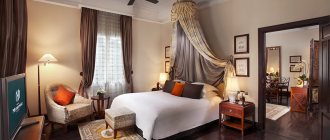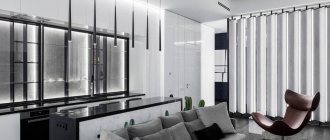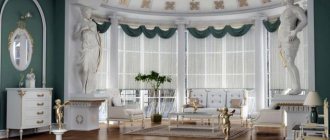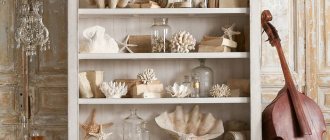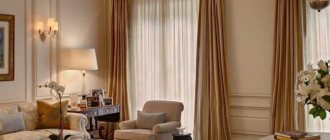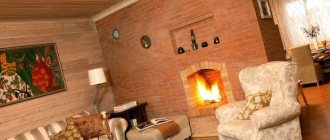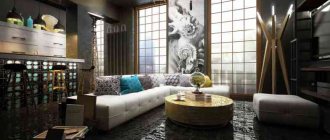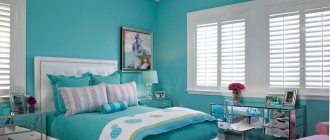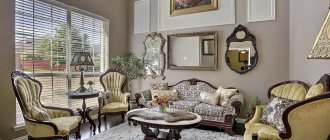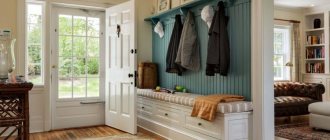Character traits
The interior of the East has a number of distinctive features.
Main features:
- The presence of functional areas separated by partitions, curtains and columns.
- Use for finishing various types of wood, metals, textiles.
- Abundance of decor and richness of finishing: carvings, colorful ornaments, floral patterns, mosaics.
- There is a minimum of furniture, the space is filled with decorative elements.
- The overall picture of the design: laconicism and functionality combined with richness, versatility and subtle taste.
Color
The richness of colors is a distinctive feature of the oriental style.
To create an oriental style, natural finishing materials are required.
Basic colors are natural natural shades:
- woody;
- ocher;
The basic colors are natural natural shades: wood, ocher, white, terracotta.
- white;
- terracotta.
Rich, pure colors add richness and oriental luxury to the interior:
- all shades of red - from ruby to burgundy;
- gold and orange;
Another Japanese style bedroom option.
- green - from malachite to emerald;
- turquoise, blue, azure.
The colors are harmoniously combined in complex floral and geometric ornaments and patterns.
Color spectrum
The East prefers bright, rich colors of warm shades.
It is advisable to include the following basic tones in the interior color scheme:
- gold;
- white;
- beige;
- red.
Complementary colors create bright accents.
Attention should be paid to the following shades:
- bright scarlet;
- blue;
- green;
- purple.
What types of oriental style are there?
In order not to mislead anyone, the designers named all varieties of oriental style by country of origin. The most popular and in demand today:
- Moroccan;
- Arab;
- Chinese;
- Indian;
- Japanese.
African and Mauritanian directions are also often included here. The characteristic features of each of the listed styles developed historically and were adopted from architecture and applied art.
The architecture of the Arab East is characterized by arches and paintings on the walls (this is also present in the interiors). The main tradition of the Japanese lifestyle is minimalism.
Arabic and Moroccan style
They are similar in many ways, so they are often combined in one project. The interiors are characterized by a rich color palette. Shades of red, green, yellow, blue, cyan, as well as violet, pink, lilac, and beige are actively used. Only in the decor of Moroccan design there is more white (it acts as a background for bright accessories and furniture).
Metallic colors may also appear in the interior of Morocco (for example, several bronze or gold details).
In terms of color, the real Arabic style is more “heavy” and complex. There is almost no white here, but burgundy, dark brown, deep blue and calm blue appear. There is a lot of gold and bright accents against their background.
There are also arches, carved partitions, and there may be colorful mosaics and paintings on the walls, floor and ceiling. Furniture in oriental style is made of expensive wood, decorated with carvings and metal elements. There must be an ottoman or a low sofa. The decoration of such a project is expensive textiles.
In Moroccan, natural fabrics with authentic patterns appear, and in Arabic there is more velvet, brocade and silk.
The rich finish is complemented by accessories. Must be present:
- decorative pillows;
- vases, wall plates;
- sconces, chandeliers and floor lamps;
- fresh and artificial flowers;
- candlesticks and thick candles;
- ceramic figurines, wall clocks.
These styles are perfect for your living room. The rich and luxurious East should not be hidden from prying eyes. Such beauty needs to be shown.
Chinese style in residential interiors
The interior looks beautiful in the Chinese direction. It is characterized by the absence of sharp corners and the predominance of yellow, green, beige, brown, and sand colors. There may be a few red spots here - this will make the room more interesting.
Lacquered furniture is rarely used in modern apartments, but it is always present in Chinese interior design. Table, cabinet, chairs - everything is made of bamboo and decorated with carvings. A door and window sills decorated with varnish will give the interior a finished look.
You can put natural stone tiles, bamboo parquet or wide dark-colored boards on the floor. A carpet that imitates a mat is suitable. The walls should be plain, gray, beige or sand shades. Paper wallpaper is suitable, but more often they use paint and cover the partitions with patterns or hieroglyphs.
You can complement the interior with Chinese fans, swords, paper lanterns, silk pillows, porcelain figurines, and black and white photos of temples.
Create Japanese style
This Asian direction accepts only natural materials. The walls are covered with paper wallpaper, light paint or wood panels. Stone, parquet or laminate are placed on the floor. The ceiling can be whitewashed and decorated with wooden beams.
To hide unevenness, wires and pipes, they make a stretch ceiling with a traditional Japanese landscape.
A fireplace with natural stone cladding will fit into such a home. The window can be decorated with curtains in the shape of a square or rectangle made of linen or cotton. Such interiors are decorated with bamboo stems, glass vases, stacks of flat stones, plain figurines, and photographs of plants.
In a one-room apartment, the room should be divided into zones with paper screens. The design will not be bright, but to make it interesting, it is recommended to add red, blue or yellow elements.
Indian style interior
A room in an Indian direction will have a unique color scheme. There are crimson, lilac, orange, turquoise, terracotta, and even indigo. These bright shades match each other and pair well with copper, gold and silver.
Light walls are decorated with intricate patterns or images of elephants and tigers. Curtains are rarely plain (mostly all with a traditional pattern).
Doorways, exits to the balcony and the windows themselves are made in the form of arches, and the space is divided by lattice partitions. Natural materials are used for decoration: linen, silk, wood, stone, metal.
Forged figurines, candlesticks, chandeliers are mandatory attributes. There should also be a low sofa, a table and soft chairs. Such a room turns out to be cozy and sincere.
Features of room design
Any room decorated based on one of the style trends of the oriental style should provide comfort. Moreover, functionality and the latest technologies are completely inappropriate here.
The eastern room is a relative, generalized concept, since the culture of the same name is quite diverse. Motifs in the interior can be elements of several eastern countries: Morocco, India, China, Japan.
The main features that characterize this style are:
- smooth shapes of furnishings;
- corridor with arches;
- vaulted ceiling;
- ornaments in the form of flowers, fruits and berries on dishes, furniture, wallpaper, textiles;
- finishing with gold, silver, semi-precious stones;
- the presence of shiny and shining surfaces;
- a huge number of small details;
- rich colors;
- luxury in every detail;
- use of natural wood.
Bedroom
An oriental style interior needs the following components:
- light weightless fabrics;
- textile;
- squat furniture made of wood with rounded shapes;
- variegated colors.
The main attribute of the bedroom is a large canopy bed. Windows should be decorated with thick curtains made of expensive fabrics with ropes, tassels and fringe. The bedroom should have an impressive number of accessories: carpets, lamps, paintings.
Another feature of this interior is the unusual headboard of the bed. It is preferable if it is forged and upholstered in velvet. As for the shape, it is the pointed headboard of the bed that looks more harmonious. It is important to choose beautiful textiles for her and pillows.
Living room design
Luxurious living rooms are a special type of design, incomprehensible to the Slavic peoples. To create it, it is customary to use the following bright shades:
- all shades of red - cold and warm;
- sand, caramel, honey, golden shades;
- brown, brick, terracotta colors;
- orange, peach, coral tones;
- colors of raspberry, fuchsia, lilac;
- emerald, turquoise, blue colors.
The walls of such a living room will be much more impressive if they are decorated with silk. This unusual wallpaper will make the interior more cozy. Another option for decorating the walls is to paint them in a pleasant shade. Painting surfaces in any red tone gives the living room a truly Chinese style.
You can decorate the living room interior with poufs, low stools, a carved coffee table, wall cabinets with matching paintings, and shelves.
Kitchen Design
When creating a kitchen design, you should use several directions. The main design features of this room are:
- combinations of warm colors;
- bright accents;
- use of natural materials;
- low furniture;
- abundance of textile elements;
- utensils for tea ceremonies.
Silk wallpaper, mosaics for the apron, and cork panels would look appropriate here. The ceiling, as in the living room and bedroom, should be decorated with elegant vaults, arches, and wooden grilles.
You can give your kitchen an oriental style using windows. Special frosted glass surfaces with Arabic motifs would look appropriate. It is allowed to install bamboo curtains and blinds.
The walls and floor can be finished with natural stone, ceramic tiles and marble. Using these materials you can decorate not only the walls and floor, but also the countertop.
Bathroom options
Decorating this room makes it possible to use all the souvenirs brought from your travels. They can decorate the interior as well as the living room. It is better to first divide this room into main zones, using partitions, screens, niches, arches, columns.
The main features of this room are rich shades, the presence of natural stone, colored glass, embossing, and forging.
Such an interior must be filled with an atmosphere of relaxation. As for plumbing, it is better to choose a classic bowl-shaped washbasin, and a beautiful rounded bathtub. It is advisable if the washbasin is made of copper, and all pipes, taps, and visible communications are painted golden. This will preserve the atmosphere of the East, without a hint of modernity. The bath itself can be placed in a special round niche in the floor.
Balcony decoration
For people who are fans of the East, the balcony can be the first place to experiment. Naturally, this place cannot be decorated with boxes of vegetables. This should be a relaxation area with wicker chairs, a glass table and a garland on the wall. All free space should be filled with flowerpots.
It is very important that there is good thermal insulation here. The bright shades present must be balanced with dark ones. It is preferable to use combinations of chocolate color with a golden tint, and burgundy with a hint of lilac.
Organza, which combines two contrasting colors, is perfect for curtains. A deep shade can show through a translucent, lighter tone. The finishing touch to such an interior will be the bright, seductive aromas of the East: grapefruit, peach, sandalwood, lemon, lemon balm. They will highlight the beauty of the interior and help you relax after a hard day.
Decor and additional accessories
All types of oriental style in the interior pay great attention to detail. However, every little thing has a specific meaning. Portraits and sculptures of people are excluded. The most preferred are ornaments. They can be anything and can be applied to almost anything: furniture, dishes, textiles, clothes, carpets, tablecloths.
A large carpet with ornaments is highly valued in the East. They can hang on the wall or cover the entire floor.
Accessories can be lamps of different sizes, on which embossing, beads, silk threads, traditional hookahs, jugs, porcelain cups, dishes for sweets, chandeliers, vases of different sizes are applied. Accessories made from bamboo are very popular.
Ideally, a small fountain, an aquarium, a waterfall, or an artificial pond would fit into a room decorated in an oriental interior.
As bright accents, you can place paper lanterns and massive fans around the perimeter of the room.
The atmosphere of a fairy tale is created by a large number of colorful textiles: cushion covers, sofa and chair covers, curtains.
Room design features
It has characteristic design features that make it difficult to confuse it with another style direction. It is distinguished by:
- Splendor, luxury, abundance of details.
- A large number of interesting patterns, complex ornaments, mosaics.
- Dim, warm lighting.
An abundance of textile elements, for the creation of which fabrics such as velvet, satin, organza, silk, and brocade are used. You can make textile accessories with your own hands or to order.
There is a smoothness of the lines, as well as a complete absence of clear geometry. Arched vaults are used to zone the room.
A special look to the room is given by furniture, which can be represented by low sofas with an abundance of soft pillows, beds with a luxurious canopy, screens, ottomans, and chests. The furniture is heavy, carved and trimmed with semi-precious stones.
The color scheme of oriental interiors is represented by natural muted shades: terracotta, ocher, beige, sky blue, lilac, crimson, orange, rich green, turquoise, sand. A golden hue is a must in an oriental-style interior. It is presented in abundance in the decor of textile elements.
Zoning
Oriental style decor in the interior is distinguished by some features, in particular, the division of the room into certain areas, each of which is designed to perform certain actions. The most important thing where it is recommended to start the design process is dividing the room into main functional areas.
If you plan to equip a large room, then it should be conditionally divided into two main zones:
- recreation;
- eating food.
But if the object is small in size, then these two zones need to be combined with each other. The relaxation area must be equipped with a large and soft sofa with many colorful pillows. A table should be placed in front of it for receiving guests and friends.
The eating area should be furnished with an impressive number of ottomans. A low table should be placed in its center.
The main requirement for pieces of furniture is comfort and convenience. Sofas should be upholstered in satin or silk. If desired, instead of colorful upholstery, you can throw a satin blanket on top.
Attention. Instead of a table, you can put a flat chest, which is covered with silk fabric. This move is more preferable for an oriental-style interior.
Finishing walls, floors, ceilings
To decorate the interior, you need to use contrasting colors or, on the contrary, soft pastels. The culture of the East combines the traditions of some countries. They are united by the use of natural raw materials: iron, wood, bamboo.
Usually the walls are finished in a minimalist style. It is characterized by the following shades: sand, cream, cherry, red, brick. All directions are characterized by the use of natural finishing materials.
The flooring can be stone or wood. The universal color of the ceiling is snow-white, but the use of a shade of the walls is allowed.
The Asian direction is characterized by a contrasting finish using beams made of dark wood, which form a rectangular lattice with fairly voluminous cells.
The Arabic style requires smooth forms, as well as exquisite painting. The ceiling can be made multi-level (stretch or suspended). The interior is perfectly emphasized by skillful carvings or overlays with its imitation.
It is recommended to paint the walls with an appropriate coloring composition or cover them with wallpaper with gold ornaments. You can use plain wallpaper in orange, peach, gold, terracotta, wine or brick shades. If you like carpets, you can decorate your interior walls with them.
Choosing furniture and textiles
In the process of choosing furniture for an oriental interior, you need to proceed, first of all, from functionality. It is best to choose options that are made of natural wood. In the Arabic style these are dark models, and in the Asian style they are bamboo.
As for the shape, there are no restrictions, but there should be no sharp corners.
When creating an interior in an oriental style, you do not need to use a lot of furniture. A sofa, a large pillow, a table for eating, a bedside table and other items if necessary will be enough. Furniture should be simple and light in color, which is why very often in such interiors you can see plain wardrobes.
As for textiles, it all depends on the direction. In Arabic design you can see a large number of carpets, curtains, capes and much more. A distinctive feature of the East is that artificial things cannot be used here, so all fabrics must be natural.
The fabric can be used not only to cover furniture, but also to decorate walls. On the windows you can often see large velvet curtains with golden shades.
When decorating an interior in an Arabic style, close attention is also paid to carpeting. They can decorate not only the floor covering, but also the wall. At the same time, it is extremely important that the product is handmade, and the color scheme does not stand out from the overall design of the room.
In large houses, such carpets are usually used to cover the stairs, but the flooring in the rooms itself is made of natural stone, so the owners prefer not to hide its beauty with anything.
Style directions
Eastern style is conventionally divided into Arabic and Asian.
The interior in the Arabic style is characterized by many details that are designed to emphasize the exquisite beauty of the room:
- bright, rich colors;
- lack of straight lines and monotony;
- the presence of vaulted ceilings;
- abundance of carvings and ornaments;
- a lot of textiles (luxurious curtains, wall drapery, plenty of pillows);
- play of light.
Arabic style in the interior is aimed at creating an atmosphere of relaxation, rest and peace.
Spacious and cozy living room in oriental style
The Asian style is characterized by minimalism. Preference is given to the following details:
- abundance of light;
- minimal occupancy of the room with furniture and decor.
Japanese and Chinese styles are laconic and restrained. The most minimalist is Japanese: it does not have the ostentatious luxury of Arabic interiors. Calm, close to natural colors (beige, brown, white); the desire for light and space, a minimum of household items - these are the key requirements of the Asian vector.
The Chinese trend is based on the ancient philosophy of Feng Shui, within the framework of which the inhabitants of these countries arrange their homes. The favorite colors of Chinese interiors are red, blue, yellow.
The many-sided oriental style finds its adherents both among fans of deliberate luxury and among supporters of minimalism in the interior.
Indian style bedroom
Finishing walls, floors and ceilings
In the process of decorating a room in an oriental style, you need to pay close attention to only two options: the use of bright and bed colors. Natural materials are considered the most preferable, among which bamboo, wood and various types of metals take pride of place.
As for the walls, relief is not necessary here, since they can be finished in any warm shades. Today, cream and beige colors are very popular and in demand.
Wood or natural stone can be used as flooring. The ceiling is usually done in white, but you can also play with contrast and make the floor and walls the same color.
In the Arabic direction, you can make fabric stretch ceilings, which look quite interesting and impressive. It can also be suspended and include several levels using an original decorative overlay with various imitations.
To decorate the walls, it is allowed to use wallpaper or regular paint. It is best to give preference to a golden or silver color of the material. The ideal wallpaper for creating an oriental-style interior is considered to be plain, but the shade must be as warm as possible.
Ceiling
The highlight of the Arabic interior is the decoration of the ceiling. Most often it is made dark (plaster or fabric), and a “starry night sky” is created against its background. In a modern interpretation, it can be covered with ornaments, using wallpaper with an oriental pattern or making a stretch panel.
Primary colors:
- white;
- shades of yellow;
- brown.
A ceiling that impresses with its rich appearance
The colors used in the ornaments are blue, red, beige and gold.
Popular ways to decorate a ceiling in an oriental style:
- smooth painted surface, decorated with beautiful cornices around the perimeter;
- a three-dimensional structure made of plasterboard, which is covered with oriental ornaments;
- drapery with fabric, which is fixed either in) where a beautiful forged chandelier is hung, or parallel to the walls;
- stretch ceiling with applied Arabic patterns;
- a hanging structure made of bamboo or other wood, characteristic of Asian style.
Decorating your own home in an oriental style involves a harmonious combination in the interior of various oriental traditions inherent in the cultures of Arab or Asian countries with European principles of comfort.
VIDEO: Beautiful and cozy east in our house or apartment
East style
Beautiful interior to note
Decor options
The choice of certain decorations and decorative elements depends, first of all, on the ethnic option. Middle Eastern style is characterized by the following decor options:
- wood carving or stucco;
- patterned tiles;
- mosaic using bright colors;
- ceramic products;
- painting.
In the process of decorating walls, you can use several types of patterns at once. The carving for the mirror frame, which resembles arches and the ceiling, will be relevant. Ceramics will be an excellent decoration for tables, cabinets and wall shelves.
The Asian version involves the use of decorative elements such as:
- painting walls and panels using various symbols and hieroglyphs;
- artificial fans on the wall;
- various lanterns that hang from a chandelier or ceiling;
- aquariums, small fountains and other sources of water;
- porcelain vases and other similar items.
An excellent way to refresh the interior is to use decorative bonsai trees, which are especially relevant for rooms decorated in Japanese style.
Style directions
Oriental style is a rather vague concept. It is mainly divided into:
- Arab;
- Asiatic.
The room with an Arabic-style interior contains the following elements.
- Lots of small details.
- All colors are rich and catchy.
- All lines are streamlined, there are no corners.
- The ceilings are vaulted.
- There is a large amount of ornamentation and carvings.
- A large number of different textiles are used in the design.
In such a room you want to relax, unwind, and escape from extraneous thoughts.
The room, decorated in Asian style, is distinguished by its minimalism. It is characterized by:
- large windows letting in a lot of light;
- a minimum amount of decor and furniture.
Separately, we can say about Japanese and Chinese styles. They are distinguished by their restraint and conciseness. More minimalist - Japanese. The room, decorated in Japanese style, is dominated by natural colors: white, gray, brown, beige.
The interior of the Chinese style is distinguished by the use of a large number of bright colors such as red, yellow, green, and blue.
People with different life principles, financial status, and political views can be lovers of oriental interiors.
Oriental style in the interior of the apartment
Apartment design in oriental style
Styling the interior of an apartment in oriental style
The East is not as far as many people think. If desired, you can create an oriental interior in an ordinary apartment. The result depends on financial capabilities. The idea is brought to life with the help of original accessories, textiles, and furniture.
To create a real design, you will need to perform complex finishing work. It is necessary to replace linoleum with stone tiles, wooden boards, laminate or parquet.
Depending on the chosen interior direction, the walls need to be painted or covered with wallpaper. For Asian interiors, wall coverings like a mat or with a complex gold pattern are suitable. A contrasting pattern should be applied to the painted partitions using a stencil. When the finishing work is completed, you can choose decorations that are characteristic of a particular style.
Living room in oriental style
Traditionally, the hall in houses and spacious apartments is decorated in Arabic style. To make the living room luxurious and cozy, dark parquet or laminate is laid on the floor, the ceiling is leveled, whitewashed and decorated with wooden beams. The walls in such a room can be painted beige or mustard and decorated with gold, purple, lilac patterns.
The window is decorated with curtains made of velvet, organza, brocade and other expensive materials. Furniture should be low, comfortable and beautiful (for example, tables with carved legs). Be sure to place several pillows with tassels on sofas and armchairs.
In the eastern living room there should be several light sources: a forged chandelier under the ceiling, a floor lamp near the sofa, sconces on the walls.
You can decorate with crystal or gilded vases, handmade wall plates, brass candlesticks, paintings in gold frames. The TV is also framed with a gold baguette. A carpet with Persian patterns is placed on the floor.
Bedroom in oriental style
The Chinese direction is suitable for the bedroom. The center of the room will be a bed without legs under a red or gray canopy. You can place a wardrobe, a bench with cushions, a table, a dressing table and other pieces of furniture made of varnished bamboo. But the space does not need to be cluttered, since nothing should interfere with the spread of daylight.
Dark brown boards should be placed on the floor, and small rugs with Chinese characters on each side of the bed.
The windows are covered with light roller blinds, and a chandelier made of dry bamboo is hung from the ceiling. A mirror or table can be separated from the rest of the room with a screen with Chinese themes. A large red fan with hieroglyphs above the berth will complement the interior.
Chinese red lanterns are a must. You can find a floor lamp or bedside lamps with scarlet lampshades.
Children's room in oriental style
This interior solution is more suitable for a girl, because in such a room she can feel like a princess.
The room does not need to be overloaded with unnecessary details. You need to find a place for a spacious bed and hide it behind a canopy. If the room is large, the window is decorated with curtains with a lambrequin; for a small child's room, Roman blinds with a pattern are suitable.
For walls, it is better to choose plain wallpaper or paint in a calm, warm shade. You can put a gold pattern on it. Wooden furniture decorated with bright mosaics is perfect. You need to put a small table and separate it with a screen.
The room should have a lot of textiles: pillows, a beautiful bedspread, a bedside rug with oriental patterns. Fragile and metal accessories are not always suitable for a child's room.
Kitchen in oriental style
The kitchen will look good in both a restrained Asian and a luxurious Arabic interior. The first option will appeal to lovers of minimalism. In a Japanese kitchen, you can make not only the floor from natural stone, but also the apron and countertop. For such areas, a laconic set of white, gray, brown or black colors is selected.
The dining room should have a glass table and simple wooden chairs. There should be nothing superfluous in the kitchen. It will be decorated only by a set of expensive Japanese knives and bamboo in a glass vase.
Arabic-style kitchen spaces are bright. The walls are painted yellow, purple, sand and decorated with patterns. A wooden set decorated with carvings fits well. You can put tiles or natural stone on the floor. The walls should be decorated with handmade plates, mosaics, and metal objects.
An oriental kitchen should also have a lot of textiles. Pillows are placed on the chairs here, and the window is decorated with thick curtains or tulle.
Hallway in oriental style
It is advisable to make the entrance zone in the Japanese or Chinese direction. There shouldn't be anything superfluous here. Plain walls and wooden floors are important. Choose comfortable multifunctional wooden furniture for the hallway. You also need a wardrobe and an ottoman.
Even in a small room you need to find a place for stylish accessories. It is advisable to place bamboo stalks in a vase or bonsai on the shelf, and decorate the wall with a sconce in the shape of a Chinese red lantern.
Bathroom in oriental style
Decorate it with dark tiles and natural stone. A wooden sink with a bronze tap will fit here, but you can put a shower stall or a regular white bathtub. The mood is created by details: glass vases, shells, river stones, bamboo soap dishes and other little things.
The Moroccan-style bathroom looks original. Its main decoration will be mosaics, a cabinet with carved bars and a bright color palette. A bathroom in white and turquoise tones with bright accents is a good interior solution.
Asian style features
The emergence of this style, its features and uniqueness, is due to the most ancient religion - Buddhism. To recreate it in the setting, you need to understand that there are Chinese and Japanese movements here. So there are big differences between them.
Japanese minimalism
He is characterized by restraint and brevity.
Main features:
- furniture made from natural raw materials: wood, bamboo, rattan;
- natural fabrics are used;
- surface decoration is absent or reduced to a minimum;
- thin-walled partitions between rooms;
- tables and beds are low, about 30 cm above the floor, there are no chairs or pillows; bolsters are used instead. A special barrel replaces the bathtub;
- there are no closets, clothes are stored in a chest or container with soft bedding;
- for the floor use smooth mats and products made from natural fibers;
- the colors in the interior have restrained shades that prevail in nature. White, green, sand, black.
Chinese motives
Unlike Japanese, Chinese culture has a rich range of colors. They are bright, must be combined with each other, and natural shades are selected.
Main elements:
- Bright drawings are often placed on walls, paintings in the form of fantastically beautiful birds, animals, trees, and flowers.
- A characteristic feature of the Chinese style is the use of screens, which divide the home into several zones and are arranged in a zigzag pattern.
- The decor consists of vases, sets, panels made of wood, straw, mosaics, and mother-of-pearl.
- Many furniture parts are made from bamboo, which is why it has become an attribute in Asian countries. Drawings of this plant are used in wall illustrations and decoration of accessories.
- To increase luck, prosperity and love in the home, accessories associated with the ancient Chinese teachings of Feng Shui are used. Therefore, it is worth purchasing symbols in the form of a figurine of Hottei - the god of prosperity, a frog or turtle with coins, and mandarin ducks.

